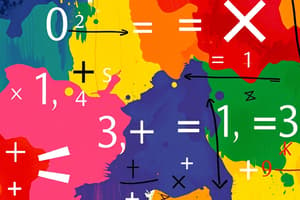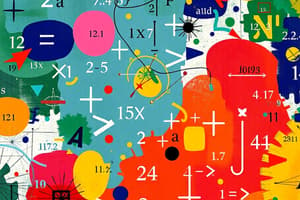Podcast
Questions and Answers
Which of the following statements is NOT true regarding perfect squares and square roots?
Which of the following statements is NOT true regarding perfect squares and square roots?
- Negative numbers have real square roots. (correct)
- The square root of a non-perfect square is always an irrational number.
- Perfect squares are non-negative numbers.
- A perfect square has an integer as its square root.
Simplify the expression: $\frac{5^6 \times 5^{-2}}{5^2}$
Simplify the expression: $\frac{5^6 \times 5^{-2}}{5^2}$
- $5^{2}$ (correct)
- $5^{4}$
- $5^{6}$
- $5^{12}$
What is the value of $(4^2 \times 4^0)^2$?
What is the value of $(4^2 \times 4^0)^2$?
- 1
- 16
- 64
- 256 (correct)
Which expression is equivalent to $\sqrt{81a^4b^6}$, assuming a and b are non-negative?
Which expression is equivalent to $\sqrt{81a^4b^6}$, assuming a and b are non-negative?
If $x = 2$ and $y = 3$, what is the value of $\frac{(x^2y)^2}{x^{-1}y^3}$?
If $x = 2$ and $y = 3$, what is the value of $\frac{(x^2y)^2}{x^{-1}y^3}$?
Given that $(a^m)^n = a^{m \times n}$, which of the following expressions is equivalent to $(2^3)^4 \times 2^{-5}$?
Given that $(a^m)^n = a^{m \times n}$, which of the following expressions is equivalent to $(2^3)^4 \times 2^{-5}$?
Which of the following correctly applies the power of a product rule to the expression $(3xy^2)^3$?
Which of the following correctly applies the power of a product rule to the expression $(3xy^2)^3$?
What is the simplified form of the expression $\frac{(a^2b^{-1})^3}{a^{-2}b^2}$?
What is the simplified form of the expression $\frac{(a^2b^{-1})^3}{a^{-2}b^2}$?
What is the prime factorization of 84 expressed in exponential form?
What is the prime factorization of 84 expressed in exponential form?
What is the Highest Common Factor (HCF) of 48 and 72?
What is the Highest Common Factor (HCF) of 48 and 72?
Determine the Least Common Multiple (LCM) of 12 and 15.
Determine the Least Common Multiple (LCM) of 12 and 15.
How is the number 6789 represented in expanded notation?
How is the number 6789 represented in expanded notation?
Represent 0.0037 in expanded decimal notation.
Represent 0.0037 in expanded decimal notation.
Which of the following pairs of numbers have a HCF of 12?
Which of the following pairs of numbers have a HCF of 12?
What is the LCM of 8 and 10, and how is it practically useful?
What is the LCM of 8 and 10, and how is it practically useful?
A clock chimes every 15 minutes and another every 25 minutes. If they chime together at 1:00 PM, when will they next chime together?
A clock chimes every 15 minutes and another every 25 minutes. If they chime together at 1:00 PM, when will they next chime together?
Express 0.000047 in scientific notation.
Express 0.000047 in scientific notation.
What is the prime factorization of 144 most useful for?
What is the prime factorization of 144 most useful for?
Flashcards
What is a square of a number?
What is a square of a number?
Multiplying a number by itself.
What is a perfect square?
What is a perfect square?
A non-negative number that has an integer square root.
What is a square root?
What is a square root?
The inverse operation of squaring a number.
What is exponent notation?
What is exponent notation?
Signup and view all the flashcards
Product of Powers Rule
Product of Powers Rule
Signup and view all the flashcards
Power of a Power Rule
Power of a Power Rule
Signup and view all the flashcards
Power of a Product Rule
Power of a Product Rule
Signup and view all the flashcards
Zero Exponent Rule
Zero Exponent Rule
Signup and view all the flashcards
Prime Factorization
Prime Factorization
Signup and view all the flashcards
Factor Tree
Factor Tree
Signup and view all the flashcards
Highest Common Factor (HCF)
Highest Common Factor (HCF)
Signup and view all the flashcards
Finding HCF (Listing Factors)
Finding HCF (Listing Factors)
Signup and view all the flashcards
Finding HCF (Prime Factorization)
Finding HCF (Prime Factorization)
Signup and view all the flashcards
Least Common Multiple (LCM)
Least Common Multiple (LCM)
Signup and view all the flashcards
Finding LCM (Listing Multiples)
Finding LCM (Listing Multiples)
Signup and view all the flashcards
Finding LCM (Prime Factorization)
Finding LCM (Prime Factorization)
Signup and view all the flashcards
Expanded Notation
Expanded Notation
Signup and view all the flashcards
Scientific Notation
Scientific Notation
Signup and view all the flashcards
Study Notes
Squares and Square Roots
- Squaring a number involves multiplying it by itself, denoted as 𝑛².
- Example: 5² = 5 × 5 = 25.
- The square of any integer is a non-negative number, called a perfect square.
- Examples of perfect squares: 1, 4, 9, 16, 25.
- Perfect squares have integer square roots.
- A square root is the inverse operation of squaring.
- If x is the square of n, then n is the square root of x, represented as √𝑥.
- Example: √25 = 5 because 5 × 5 = 25.
- Square roots of non-perfect squares result in irrational numbers (e.g., √2).
- Negative numbers do not have real square roots.
Exponent Notation
- Exponent notation is a shorthand for repeated multiplication, written as 𝑎ⁿ.
- 𝑎 is the base, and 𝑛 is the exponent or power.
- Example: 3⁴ = 3 × 3 × 3 × 3 = 81.
- Product of Powers: 𝑎ᵐ × 𝑎ⁿ = 𝑎ᵐ⁺ⁿ (add exponents when multiplying numbers with the same base).
- Power of a Power: (𝑎ᵐ)ⁿ = 𝑎ᵐ×ⁿ (multiply exponents when raising a power to another power).
- Power of a Product: (𝑎𝑏)ⁿ = 𝑎ⁿ × 𝑏ⁿ (distribute the exponent across the product).
- Power of a Fraction: (𝑎/𝑏)ⁿ = 𝑎ⁿ/𝑏ⁿ (exponent applies to both numerator and denominator).
- Zero Exponent: 𝑎⁰ = 1 (any non-zero number raised to the power of zero equals 1).
- Negative Exponent: 𝑎⁻ⁿ = 1/𝑎ⁿ (negative exponent represents the reciprocal of the base raised to the positive exponent).
Prime Factor Form (and Factor Trees)
- Prime factorization breaks down a number into its prime factors.
- A prime number is greater than 1 and divisible only by 1 and itself.
- Example: The prime factorization of 36 is 2² × 3².
- A factor tree is a visual tool to find the prime factorization.
- Start by dividing the number by its smallest prime factor and continue dividing each quotient.
- Example: Factor tree for 36: 36 → 2 × 18 → 2 × 2 × 9 → 2 × 2 × 3 × 3.
- Prime factorization is used to find the greatest common divisor (GCD) and the least common multiple (LCM).
Common Factors (HCF)
- The Highest Common Factor (HCF), also called the Greatest Common Divisor (GCD), is the largest number that divides two or more numbers exactly.
- To find the HCF of 24 and 36, list the factors of each number.
- Factors of 24: 1, 2, 3, 4, 6, 8, 12, 24
- Factors of 36: 1, 2, 3, 4, 6, 9, 12, 18, 36
- The common factors are 1, 2, 3, 4, 6, and 12, so the HCF is 12.
- Using prime factorization:
- 24 = 2³ × 3
- 36 = 2² × 3²
- HCF is the product of the lowest powers of all common prime factors, so the HCF is 2² × 3 = 12.
- The HCF simplifies fractions and solves problems involving divisibility and sharing.
Common Multiples (LCM)
- The Least Common Multiple (LCM) is the smallest number that is a multiple of two or more numbers.
- The LCM of 4 and 5 is 20.
- List the multiples of each number and identify the smallest common one.
- Multiples of 4: 4, 8, 12, 16, 20, 24,...
- Multiples of 5: 5, 10, 15, 20, 25,... The LCM is 20.
- Using prime factorization:
- 4 = 2²
- 5 = 5¹
- LCM = 2² × 5 = 20
- The LCM solves problems involving synchronization.
Expanded Notation
- Expanded notation shows the value of each digit based on its place value.
- Example: 3456 = 3000 + 400 + 50 + 6.
- Scientific notation expresses numbers as a product of a coefficient between 1 and 10, and a power of 10.
- Example: 5000 = 5 × 10³.
- Decimal notation deals with fractional parts.
- Example: 0.045 = 4 × 10⁻² + 5 × 10⁻³.
Studying That Suits You
Use AI to generate personalized quizzes and flashcards to suit your learning preferences.




